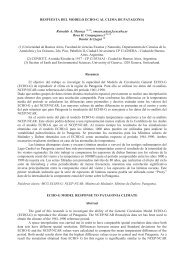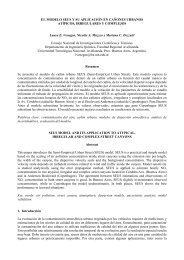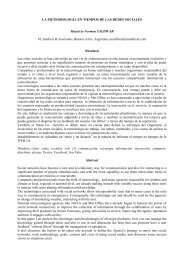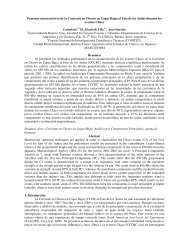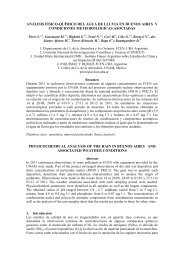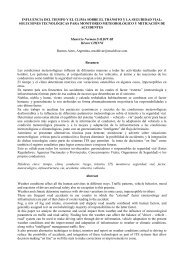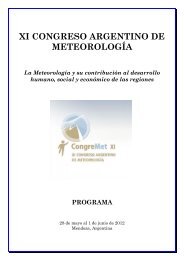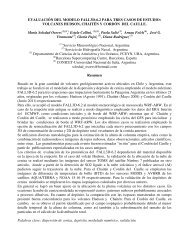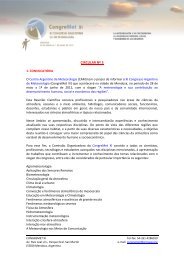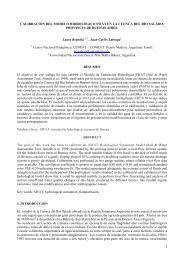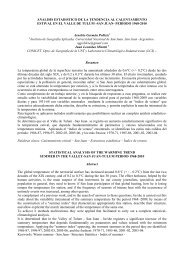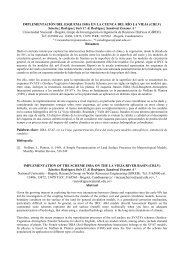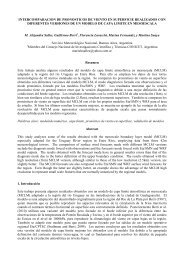estudo climatológico a partir de registros naturais em anéis de ...
estudo climatológico a partir de registros naturais em anéis de ...
estudo climatológico a partir de registros naturais em anéis de ...
You also want an ePaper? Increase the reach of your titles
YUMPU automatically turns print PDFs into web optimized ePapers that Google loves.
ESTUDO CLIMATOLÓGICO A PARTIR DE REGISTROS NATURAIS EM ANÉIS DEÁRVORES OBTIDOS NA FLORESTA NACIONAL DE PIRAÍ DO SUL – PARANÁ,BRASIL1 Lauren Catherine Brum Göergen (UFSM – Bolsista PROBIC/FAPERGS); 2 Luete AmaralGue<strong>de</strong>s(UFSM - Bolsista PIBIC/CNPq); 1 Thaís Stochero Teixeira(UFSM - Bolsista PRAE);3 Alan Prestes (UNIVAP); 4 Nivaor Rodolfo Rigozo(CRS/INPE, Orientador)1 Aluna do Curso <strong>de</strong> Meteorologia - UFSM, Santa Maria, Brasil²Aluna do Curso <strong>de</strong> Engenharia Florestal - UFSM, Santa Maria, Brasil3 Físico, Dr., Professor - UNIVAP, São José dos Campos, Brasil4 Físico, Dr.– CRS/INPE, Santa Maria, Brasile-mail: lauren.goergen@hotmail.comResumoA <strong>partir</strong> do método cientifico datação cronológica absoluta, inventado e <strong>de</strong>senvolvido por A. E.Douglass, a <strong>de</strong>ndrocronologia estabelece a ida<strong>de</strong> <strong>de</strong> uma árvore, com fundamentação nospadrões dos anéis <strong>de</strong> seu tronco. Em cada amostra <strong>de</strong> árvore, os anéis encontrados estabelec<strong>em</strong>o clima <strong>de</strong> t<strong>em</strong>pos passados, e por isso, torna-se um gran<strong>de</strong> aliado na produção <strong>de</strong> dadosclimatológicos <strong>em</strong> épocas ou <strong>em</strong> regiões on<strong>de</strong> não se po<strong>de</strong>riam instalar as estaçõesmeteorológicas. Em algumas espécies <strong>de</strong> árvores, sensíveis ao meio ambiente, são registradas<strong>em</strong> seus troncos, anéis <strong>de</strong> crescimento que são formados <strong>de</strong> acordo com fatores ambientais <strong>de</strong>seu habitat, umida<strong>de</strong>, solo, t<strong>em</strong>peratura, radiação solar. Assim <strong>de</strong>vido o diferencial docrescimento das células, nota-se a variação da coloração no lenho, formando um lenho claro(lenho inicial ou primaveril) quando encontra fatores favoráveis ao crescimento e um lenhoescuro (lenho tardio ou outonal) quando os fatores não são favoráveis ou quando a árvore entra<strong>em</strong> período <strong>de</strong> dormência. Em regiões on<strong>de</strong> o clima é claramente <strong>de</strong>finido <strong>em</strong> verão e invernoou chuvas e secas é possível, <strong>em</strong> <strong>de</strong>terminadas espécies, fazer a relação <strong>de</strong> números <strong>de</strong> anéiscom a ida<strong>de</strong> da árvore. Para este <strong>estudo</strong>, foram analisadas 15 amostras <strong>de</strong> árvores, Araucariaangustifólia, coletadas na Floresta Nacional <strong>de</strong> Piraí do Sul – Paraná, Brasil. A FLONA(Floresta Nacional) está localizada aproximadamente a uma longitu<strong>de</strong> <strong>de</strong> 49°54’42”O a49°56’12”O e latitu<strong>de</strong> <strong>de</strong> 24°34’13”S a 24°36’44”S <strong>de</strong>ntro <strong>de</strong> uma Zona <strong>de</strong> Amortecimentocom raio aproximado <strong>de</strong> 10 km a uma longitu<strong>de</strong> média <strong>de</strong> 49°48’16”O a 50°1’46”O e latitu<strong>de</strong>média <strong>de</strong> 24°29’10”S a 24°40’45”S, sendo que a floresta contém um bioma <strong>de</strong> Mata Atlânticacom Floresta Ombrófila Mista, Vegetação Secundária e Ativida<strong>de</strong>s Agrícolas. Como primeiraetapa do <strong>estudo</strong>, foi feita a i<strong>de</strong>ntificação dos anéis verda<strong>de</strong>iros e falsos. Após isto, v<strong>em</strong> oprocesso <strong>de</strong> medição das espessuras dos anéis <strong>de</strong> árvores e datação <strong>de</strong> cada anel. No qual foifeito a medição do anel inteiro, da parte do lenho inicial e da parte do lenho tardio, obtendoassim, três séries t<strong>em</strong>porais, distintas. Na segunda etapa, irá ser feita a correlação dos dadosobtidos, <strong>de</strong> cada amostra, com os dados <strong>de</strong> precipitação e t<strong>em</strong>peratura do local. A fim <strong>de</strong>encontrar possíveis sinais da variação do clima local ou <strong>em</strong> escala maior, como os eventos ElNiño e La Ninã, que possam estar afetando o crescimento dos anéis <strong>de</strong> árvores.Palavras chave: Anéis <strong>de</strong> crescimento, climatologia, El Niño, La Ninã, séries t<strong>em</strong>porais.
CLIMATOLOGICAL STUDY FROM NATURAL RECORDS IN TREE RINGS MADEIN NATIONAL FOREST SOUTH PIRAÍ – PARANÁ, BRAZILAbstractFrom the scientific method of absolute chronological dating, invented and <strong>de</strong>veloped by A. E.Douglass, the <strong>de</strong>ndrochronology establishes the age of a tree, with the reasoning of patterns inthe rings of its trunk. In each sample tree, the rings found establish the climate of the past, andtherefore becomes a great ally in the production of climatologically data in times or in areaswhere one could not install the weather stations. In some tree species, environmentallysensitive, are recor<strong>de</strong>d in the trunk, growth rings which are formed according to environmentalfactors of their habitat, humidity, soil, t<strong>em</strong>perature, solar radiation. Thus owing the differentialgrowth of cells, notices the change of color in the wood, forming a clear wood (ealywood orspringlike) when it encounters factors favorable to growth and a dark wood (latewood orautumnal) when the factors are not favorable or when the tree goes into dormancy period. Inregions where the climate is clearly <strong>de</strong>fined in summer and winter or rainy and dry is possible incertain species, make a relationship of numbers of rings at the age of the tree. For this study, weanalyzed 15 samples of trees, Araucaria angustifolia, collected in the National Forest PiraíSouth – Paraná, Brazil. The FLONA (National Forest) is located an approximate longitu<strong>de</strong>49°54’42”W till 49°56’12”W and latitu<strong>de</strong> of 24°34’13”S till 24°36’44”S within a ZoneDamping with approximate radius of 10 Km, at an average longitu<strong>de</strong> of 49°48’16”W till50°1’46”W and latitu<strong>de</strong> of 24°29’10”S till 24°40’45”S, being that the forest contains anAtlantic Forest biome with Araucaria Forest, Secondary Vegetation and Agricultural Activities.As a first step of the study was performed the i<strong>de</strong>ntification the true and false rings. After thisprocess comes the thickness measur<strong>em</strong>ent and chronological dating of each ring. In which, th<strong>em</strong>easur<strong>em</strong>ent was done in the whole ring, the part of earlywood and the part of latewood,thereby obtaining three time series, distinct. In the second stage, will be done a correlation ofdata obtained from each sample, with the precipitation data and local t<strong>em</strong>perature. In or<strong>de</strong>r tofind possible signs of variations in local climate or on a large scale, as events El Niño and LaNiña, of which may be affecting the growth rings of tree.Keywords: growth rings, climatology, El Niño, La Niña, time series.



